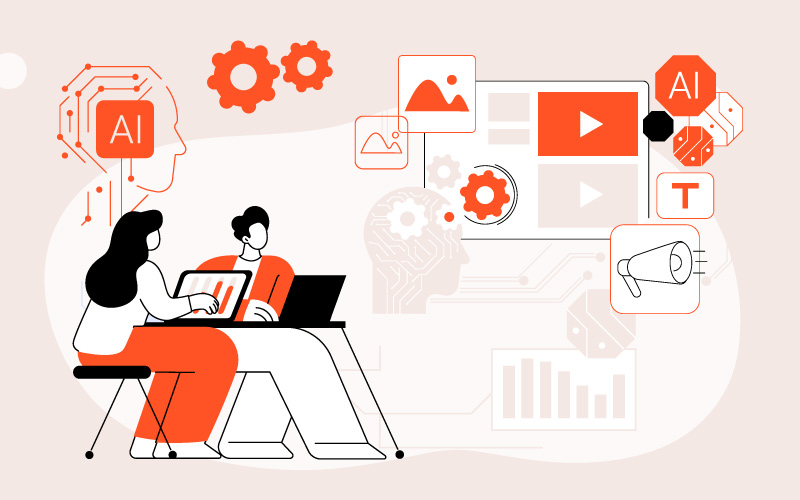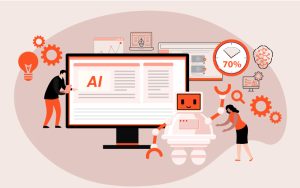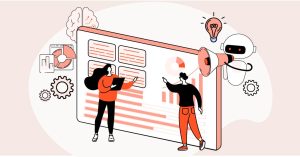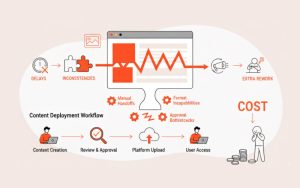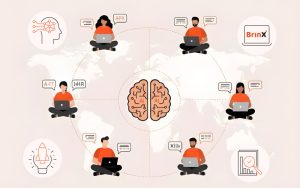Most L&D teams already work fast. The issue sits in how the work moves- linear, approval-heavy, and segmented. Each step waits for the one before it to finish. Design, review, media, deployment. Nothing wrong in principle. It is how enterprise systems evolved- predictable, repeatable. Until the business cycle outgrew it.
AI entered quietly. Not as a solution to creativity, but as a reconfiguration of sequence. The order of work changes when generation, synthesis, and validation can occur in parallel. The same design that took 12 weeks becomes possible in less than two. Not because people move faster, but because dependencies collapse.
Where Project Delays Usually Occur
Every organization knows the hidden calendar inside a project plan. The waiting time. Drafts pending review, scripts awaiting feedback, SCORM uploads paused for QA. The sum of these gaps often exceeds actual production time. Traditional learning teams treat these as constants- inevitable friction.
AI systems do not remove review cycles; they compress the intervals between them. A draft script can appear minutes after an outline. A visual storyboard can be simulated before narration begins. The downstream pieces start earlier. When outputs are machine-generated, the first version arrives almost instantly, allowing iteration to begin sooner.
There is still human judgment. But it happens on a moving surface, not a blank page.
Why Faster Isn’t Always Better
Shorter cycles create the illusion of efficiency. Some teams interpret AI output volume as progress. That is misleading. Volume only helps if alignment is high. The better metric is reduction in lag time between intent and iteration.
In practice, this looks like design sessions that shift from “what to build” to “what to keep.” The first draft is now a simulation of multiple options- tone, sequence, visual density. L&D teams can compare and discard faster. It feels procedural, but it is strategic: feedback moves upstream.
One retail enterprise reduced course design sprints from 10 weeks to 2 by front-loading ideation with an AI writing model. But they still spent 40% of total hours refining instructional flow. The difference was timing- effort redistributed, not reduced.
How Ai Changes Team Ownership
When generation becomes near-instant, the question of who starts first disappears. Instructional designers, SMEs, and media teams work concurrently. AI produces placeholder assets- scripts, scenes, quiz frameworks- that enable simultaneous review.
This parallelization reduces waiting, but also changes authority. SMEs can intervene mid-design rather than post-delivery. Designers can preview assessment logic before the storyboard freezes.
It blurs boundaries that used to protect quality through order. That can create discomfort. Some leaders report initial resistance from teams used to linear control. But once restructured, collaboration shifts from handoffs to checkpoints.
Why Context Still Slows Automation
Automation does not always speed up what matters. Context takes time. Translating generic outputs into organization-specific tone, compliance phrasing, or brand design cannot be bypassed. AI accelerates the creation layer, not the integration one.
Teams that underestimate this end up reworking assets. Many early adopters saw content multiplied, not delivered. The bottleneck moved from creation to alignment.
The solution emerged from workflow design, not technology. Some teams built controlled prompt libraries- pre-approved templates for tone and terminology. Others created post-generation editors trained on internal content patterns. The gain was not faster creation, but fewer revisions.
How Review Cycles Work Differently Now
Traditional review cycles begin after production. With AI, they begin during it. Generated drafts are immediately visible. Stakeholders react in real time. That changes the emotional economy of approval.
Instead of sign-offs on near-final pieces, teams now review evolving prototypes. The cycle becomes continuous. Some organizations report initial fatigue- too many touchpoints, too little structure. Others found it reduced rework by half.
The key is version control. Without it, “faster” quickly becomes “messier.” AI systems output infinite variants. Human teams must decide what counts as a milestone. Without boundaries, iteration becomes drift.
Redesigning Workflows For Faster Delivery
Shrinking timelines does not mean deleting steps. It means re-mapping them. In one global manufacturing company, the L&D team rebuilt its workflow around what could run in parallel.
- Content framing, script drafting, and asset planning started on day one.
- SME feedback moved from phase-end to mid-phase.
- Localization began before final narration.
The cycle shortened from 14 weeks to 4. The workload was the same. The order was not.
AI tools- language models, video generators, adaptive design systems- made this viable. But they worked because someone redesigned the map. Together, they form the base of AI-powered learning workflows, but they worked because someone redesigned the map.
How Ai Speeds Key Production Stages
Three domains show the largest compression effects: scripting, media production, and QA. Each behaves differently, but together they create measurable acceleration.
-
Scripting: Language models now generate structured outlines that follow cognitive load guidelines. Designers adjust tone and sequence directly, compressing early drafting from days to hours.
-
Media production: Visual generation tools synthesize learning scenes from storyboards, creating usable video drafts almost instantly. Rendering queues that once took days now close within an hour.
-
Quality assurance: Automated systems review accessibility tags, captions, and branching logic before manual inspection. Errors surface early, reducing final QA cycles by several days.
Each domain improves at a different rate, but when connected through the same workflow, the total cycle time drops sharply.
The Infrastructure Behind True Speed
Fast output still depends on infrastructure readiness. Many enterprises have legacy LMS or LCMS systems that cannot handle dynamic updates or API-based publishing. AI tools can generate rapidly, but if deployment depends on manual uploads or compliance freezes, the gain disappears.
Some L&D teams now operate on “content pipelines,” where AI generation connects directly to repository management and deployment layers. It resembles DevOps- continuous integration applied to learning assets. That alignment matters more than model sophistication.
Without it, organizations produce faster but release slower. The bottleneck just shifts downstream.
Balancing Accuracy And Faster Pace
Compression carries a trade-off. AI speeds generation, but quality assurance becomes proportionally heavier. One error in early output propagates faster through the chain.
This risk is procedural, not technological. Human checkpoints must scale with automation volume. Some enterprises instituted “AI checkpoints”- micro reviews every 48 hours. Others limited generation to defined stages, maintaining human authorship in core instructional logic.
There is no universal balance. Each team defines tolerance differently. A compliance-heavy industry cannot risk unverified phrasing. A sales enablement team may accept minor inconsistencies for faster rollout. Both are valid.
Managing Change, Not Just Tools
AI’s effect on L&D timelines is mostly organizational. Technology adoption is simple; process discipline is not.
Teams that gain the most often create hybrid roles- AI editors, workflow designers, data auditors. These people translate between instructional design and system capability. The structure resembles operations engineering more than training design.
One insurance firm added an “AI production manager” role to coordinate output review and system prompts. Their course cycle time dropped by 65%. No new headcount. Just realignment.
Without such roles, automation can fragment responsibility. Everyone touches the process; no one owns it. That kills momentum faster than slow software ever did.
Using Data Loops For Improvement
Once AI becomes part of the L&D workflow, the same system can collect feedback loops automatically. Usage analytics, completion time, engagement patterns- fed back into the model.
That feedback cycle compresses improvement timelines. Instead of quarterly updates, content refreshes occur weekly. Small tweaks accumulate quietly.
But the data must be clean. Poor tracking nullifies speed gains. If completion metrics are inconsistent, adaptive models learn the wrong patterns. Speed without validation increases error velocity.
Some teams now maintain separate QA data streams just for AI performance monitoring. It is procedural overhead, but necessary.
From Production Cycles To Live Iteration
AI collapses the distinction between creation and revision. The process feels less like manufacturing, more like live editing. That demands a mindset shift inside L&D teams.
Earlier, completion marked success. Now, iteration speed does. A course may launch in draft mode and evolve post-release. This continuous rollout fits modern product cycles but disrupts traditional learning governance.
Compliance sign-offs, translation locks, version freezes- all those constructs slow down adaptive design. Enterprises that cling to them will see minimal gains. Those that relax structure- within policy- see compounding benefits.
Scaling Enterprise Learning With Ai
In the old model, doubling output required doubling hours or headcount. In the AI model, scale follows data leverage. Once a prompt library, tone guideline, and visual system are in place, replication cost per module drops sharply.
One multinational built 200 product modules in the time previously used for 20. Not identical quality across all, but operationally sufficient for rollout. Perfection became situational. The system prioritized coverage over craftsmanship.
That trade-off makes sense in enterprise learning, where most content expires in under 18 months. The ROI equation favors timeliness over artistry.
Maintaining Discipline Amid Faster Creation
When generation becomes instant, control becomes the constraint. Teams can now create faster than they can manage. That shifts the focus from speed to governance.
To maintain coherence, many organizations formalized discipline through structured guardrails:
Tagging systems to classify every generated asset by use case and stage.
Review gates that define when AI drafts move to human validation.
Deletion protocols to remove redundant or low-value content before it floods repositories.
Without these, repositories fill with half-finished material. AI increases creation frictionlessness; human discipline must match it.
Some leaders now measure success not by how much is produced, but by how much survives to active deployment.
What Remains Human In L&D
AI shortens timelines, but design intelligence- the ability to frame learning purpose, interpret behavioral data, and align experience to business metrics- remains human. That work is slower, interpretive, and context-bound. Machines assist, but they do not infer organizational nuance.
In most teams, that human layer is where the new time advantage accumulates. Less time drafting, more time refining structure, pacing, and interaction. The ratio shifts.
Eventually, L&D may resemble analytics: continuous input, periodic recalibration. Production becomes maintenance. The backlog disappears, but only because the process never stops.
The Real Transformation In Workflow Speed
Acceleration is mechanical. Alignment is strategic. AI compresses the visible parts of the workflow- the drafts, the renders, the checklists. But the invisible parts- judgment, validation, coherence- remain manual.
Shrinking timelines is not the same as simplifying them. It is rebalancing where thinking happens.
And for most enterprise learning teams, that is where the real transformation lies.
With BrinX.ai, you can build systems to make it all possible- intelligent infrastructure for modern learning teams. If your L&D function is ready to move from backlog to rollout, let’s talk.

FAQs
What is adaptive learning, and how does AI contribute to it?
Adaptive learning adjusts the experience to the performance, preferences, and speed of individual learner. By altering the trip based on real-time data analysis of what a learner clicks, skips, or struggles with, artificial intelligence improves this.
Can AI really generate full courses from raw content?
Yes. Certain AI-powered services can analyze SOPs, manuals, and slide decks to generate structured modules with assessments and objectives. Although they significantly cut down on production time, these drafts still benefit from human inspection.
How is gamification supported by AI?
AI doesn’t create game mechanics, but it sets the foundation. It structures learning into modules, which instructional designers can then gamify, adding points, scenarios, or progress indicators that motivate learners.
What’s the benefit of combining AI and microlearning?
Complex material is decomposed by AI into goal-aligned, modular building pieces that are ideal for microlearning. This facilitates the creation of brief, efficient, and time-spaced learning excursions that improve retention.
Is this approach scalable across a global workforce?
Yes. AI-assisted course development is particularly effective at scaling training in domains where consistency is crucial and source information is already available, such as compliance, product knowledge, and onboarding.
Do I need to buy a platform to use this kind of AI course builder?
Not always. Some services, like the one developed under MITR, offer course generation as a project-based model, no platform lock-in, no licenses, just a secure workflow and editable output.
Can human instructional designers still add value after AI builds the draft?
Absolutely. In fact, they’re essential. AI handle’s structure and speed; humans bring voice, empathy, and interactivity. It’s not either-or, it’s a partnership.
How secure is this process when using sensitive documents?
Best-in-class tools encrypt content, never store source material beyond delivery, and meet enterprise privacy standards. Always check for data handling policies before sharing internal content.

Soft Skills Deserve a Smarter Solution
Soft skills training is more than simply information. It is about influencing how individuals think, feel, and act at work, with coworkers, clients, and leaders. That requires intention, nuance, and trust.


